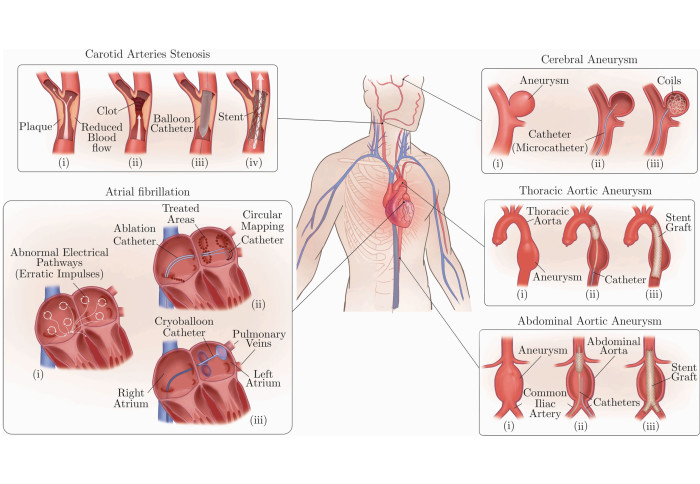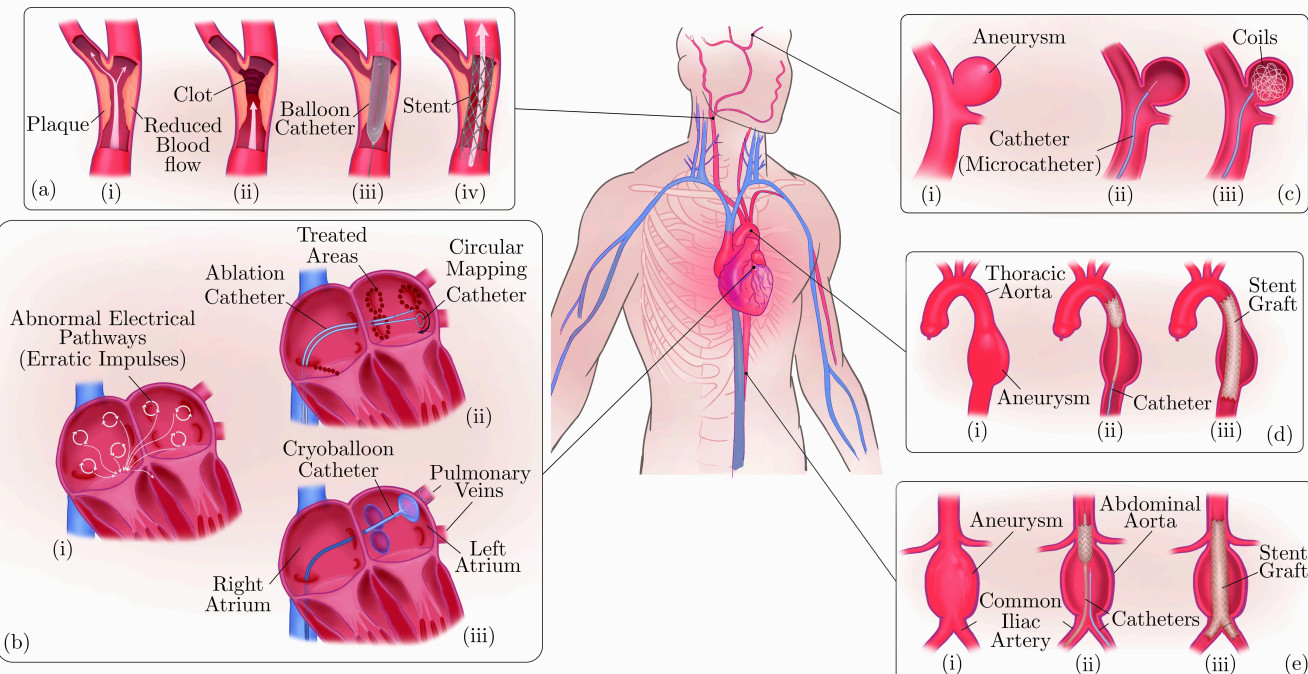X-Ray to MR: The Progress of Flexible Instruments for Endovascular Navigation


Hamlyn researchers provided a systematic review of the flexible instruments for endovascular navigation, aiming to aid X-Ray & MRI treatment for CVDs.
Cardiovascular diseases (CVDs) are disorders and diseases affecting the heart or blood vessels, which lead to heart attacks, strokes, critical leg ischemia, and account for one-third of all deaths in the world (17.9 million annually).

Endovascular interventions have become the backbone of treatment for CVDs (especially utilising in X-Ray and magnetic resonance imaging (MRI) treatments), thanks to its minimally invasive nature and its effectiveness in reducing hospitalisation and total time to recovery when compared to open surgery.
The minimally invasive and image-guided procedures of endovascular interventions are carried out by manipulating thin, long, and relatively flexible instruments (sheaths, catheters, and guide-wires) within the vasculature to gain access to specific blood vessels, commonly referred to as catheterisation.
X-Ray to MRI
Although X-Ray fluoroscopy is currently the gold standard imaging technique for endovascular interventions, it presents occupational safety hazards to medical personnel and potential risks to patients, especially paediatric patients, because of its inherent ionising radiation.
On the other hand, MRI (with its unique ability to provide radiation-free imaging, and acquiring morphologic and functional information) holds great promise in the advancement of image-guided navigation through the vasculature. Moreover, MRI has the potential to combine diagnosis, therapy and early evaluation of therapy in the same intervention.
However, MR-guided interventions also face a major challenge due to the presence of a large magnetic field (1.5/3 Tesla), which limits the set of materials suitable for the construction of key instrumentation (sheaths, catheters and guide-wires). Yet, significant progress has been made in the development of interventional devices, which comprise biocompatible, MR safe and MR visible materials.
The Progress of Flexible Instruments for Endovascular Navigation - A Systematic and Illustrated Review
In view of this, our researchers at the Hamlyn Centre provided a systematic and illustrated review regarding the progress of flexible instruments for endovascular navigation, aiming to encourage and accelerate the development of MR-guided endovascular instrumentation, as well as assist X-Ray & MRI treatments for CVDs.
This systematic review covered three main categories (keywords for literature up-to-date search [until October 2020 inclusive] are listed in brackets): (a) instrument (MR/MRI/magnetic resonance (imaging), guide∗, guide-wire, steer∗, deflect∗, selective), (b) medical region (card∗, heart∗, atri∗, vasc∗), (c) instrument tracking (MR/MRI/magnetic resonance (imaging), device tracking, catheter tracking, visualisation).
In this review, our researchers
- first introduced commercial guide-wires and selective catheters, as well as the current state-of-the-art devices used for navigational purposes in endovascular interventions;
- presented the strengths and limitations of these instruments in terms of navigation in the human vasculature and their accompanied side effects (mainly increased exposure to ionising radiation);
- reviewed commonly proposed techniques (i.e., steerable catheters and robotic platforms) to overcome the navigational challenges and limitations of performing interventions under X-Ray fluoroscopy guidance;
- subsequently presented a commonly proposed and investigated route, i.e. adopting MRI as an alternative imaging modality for its unique strength and capabilities when compared to X-Ray fluoroscopy;
- briefly went through the fundamental physics of MRI, followed by showcasing the ongoing efforts made by academia and industry to develop instruments compatible for use in MR environments through the adoption of different materials and manufacturing methods;
- outlined MRI's huge potential in combining diagnosis, therapy and early evaluation of therapy in the same intervention; and
- used this systematic review as a base for defining the future requirements and challenges of developing MR safe and visible instrumentation for endovascular interventions.
Data Availability Statement: The 3D CAD models (Solid-works and STEP files) used in this article are openly available in the fig-share repository: please click Here.
This research was supported by EPSRC Programme Grant “Micro-robotics for Surgery (EP/P012779/1)” (Mohamed E M K Abdelaziz, Libaihe Tian, Mohamad Hamady, Guang-Zhong Yang and Burak Temelkuran, "X-ray to MR: the progress of flexible instruments for endovascular navigation", Progress in Biomedical Engineering, 3 (3), August 2021).
Supporters
Article text (excluding photos or graphics) © Imperial College London.
Photos and graphics subject to third party copyright used with permission or © Imperial College London.